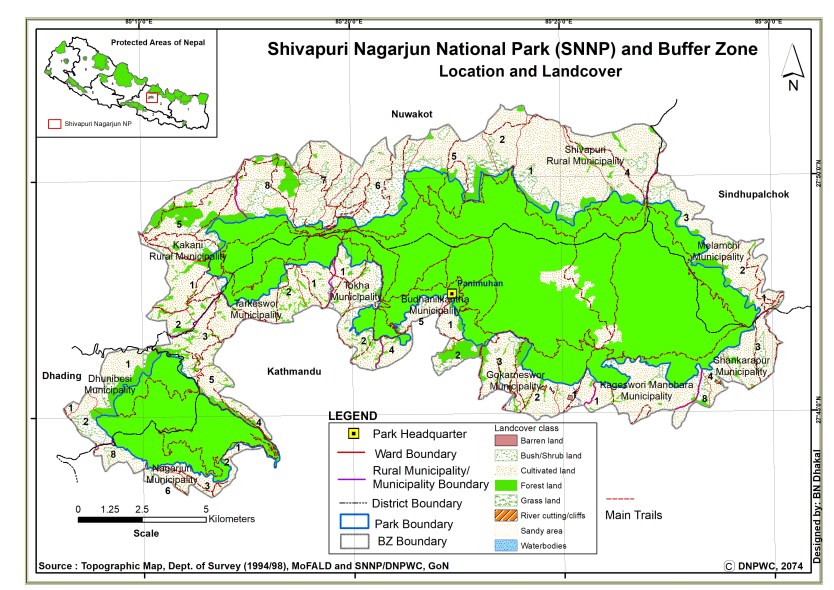Shivapuri Nagarjun National Park is a protected area located in the northern region of Kathmandu Valley, Nepal. The park was established in 2002 and covered an area of 159 sq km. It is named after the two main peaks within the park, Shivapuri and Nagarjun, which are considered sacred by both Hindus and Buddhists.

Shivapuri Nagarjun National Park offers visitors a unique opportunity to experience the beauty and diversity of Nepal’s natural environment. Covering an area of 159 sq km, the park is inhabited by a wide variety of flora and fauna, including over 300 species of birds, 19 species of mammals, and 129 species of butterflies.
Flora and Fauna
Shivapuri Nagarjun National Park is inhabited by a rich diversity of flora and fauna, making it a popular destination for nature lovers and wildlife enthusiasts. Here are some of the highlights:
- Over 500 species of plants thrive in the park, including rhododendrons, oaks, pines, and maples.
- The park’s diverse vegetation includes several medicinal plants that are commonly used in traditional Ayurvedic medicine.
- Visitors can witness a vast array of plant life, with over 500 species of flora found within the park.
- The park is a sanctuary for wildlife enthusiasts, with over 19 mammal species inhabiting the area, such as the Himalayan black bear, red panda, leopard, and wild boar.
- Birdwatchers will be delighted by the park’s impressive avian population, which includes over 300 species such as the endangered Spiny Babbler and Impeyan Pheasant.
- The park’s diverse landscape also harbors several species of reptiles and amphibians, including the Common Cobra and Himalayan Newt.
Visitors to the park can experience the rich biodiversity of the area by hiking through the forests, camping, bird watching, and wildlife viewing. The park has implemented several conservation initiatives to protect and preserve its unique flora and fauna.
Water Resources
Shivapuri, located in the northern part of Kathmandu Valley, is a vital watershed area that serves as a significant source of drinking water for the valley’s residents. Every day, around 30 million liters of water are tapped from rivers such as the Bagmati and the Bishnumati, as well as several other smaller streams, originating from Shivapuri’s pristine forests.
Shivapuri is a crucial natural resource that provides clean and fresh water to the Kathmandu Valley. The water from Shivapuri is treated and supplied to the households, industries, and institutions in the valley, ensuring the basic needs of the people are met.
6 Attractions of the Park
Shivapuri Nagarjun National Park is a popular destination for visitors who are interested in exploring the natural beauty of Nepal. Here are some of the top attractions that you can find within the park:
- Hiking Trails: The park offers a range of hiking trails catering to novice and experienced hikers. The trails vary in length and difficulty and offer stunning views of the surrounding mountains and valleys.
- Shivapuri Peak: At 2,732 meters, Shivapuri Peak is the highest point in the park. Visitors can hike to the peak and enjoy panoramic views of the Kathmandu Valley.
- Buddhist Monasteries: The park is home to several Buddhist monasteries, including the famous Nagi Gompa and Shivapuri Baba Ashram. Visitors can learn about Buddhism and meditation practices, and enjoy the peaceful surroundings.
- Birdwatching: With over 300 species of birds, the park is a paradise for birdwatchers. Visitors can spot a range of colorful birds, including the endangered Spiny Babbler and Impeyan Pheasant.
- Wildlife Viewing: The park is home to a diverse range of wildlife, including the Himalayan black bear, red panda, and leopard. Visitors can go on guided tours and observe these animals in their natural habitats.
- Camping: The park offers several camping sites, where visitors can enjoy the tranquility of the wilderness and experience Nepal’s natural beauty up close.
Overall, Shivapuri Nagarjun National Park offers a range of attractions that cater to different interests and preferences. Whether you are a hiker, a nature enthusiast, or simply looking for a peaceful retreat, the park has something to offer.
The attraction of the Park
One of the main attractions of the park is Shivapuri peak, which stands at an elevation of 2,732 meters and offers stunning panoramic views of the surrounding Himalayan mountains. The peak can be reached via various hiking trails that wind through the park’s lush forests and past picturesque waterfalls.
6 Activities in the park
Shivapuri Nagarjun National Park is a hub for outdoor activities that let you experience the natural beauty of Nepal. Here are some of the top activities that you can enjoy in the park:
- Hiking: With a range of trails of varying difficulty, hiking is one of the most popular activities in the park. You can explore the lush forests, spot wildlife, and enjoy panoramic views of the surrounding mountains and valleys.
- Birdwatching: The park is home to over 300 species of birds, making it a paradise for birdwatchers. You can spot a range of colorful birds, including the endangered Spiny Babbler and Impeyan Pheasant.
- Wildlife Viewing: The park is the habitat of a diverse range of wildlife, including the Himalayan black bear, red panda, leopard, and wild boar. You can go on guided tours and observe these animals in their natural habitats.
- Photography: The park offers endless opportunities for nature photography, with its stunning landscapes, wildlife, and flora. You can capture the beauty of Nepal and its unique ecosystem through your lens.
- Camping: The park offers several camping sites where you can enjoy the tranquility of the wilderness and experience Nepal’s natural beauty up close. You can stargaze, go on night walks, and enjoy a bonfire under the stars.
- Meditation: This is the land of several Buddhist monasteries, including the famous Nagi Gompa and Shivapuri Baba Ashram. Visitors can learn about Buddhism and meditation practices and enjoy the peaceful surroundings.
Cultural Significiant
For those interested in history and culture, the park is also home to several important religious sites, including the Bagdwar and Bishnudwar temples. These temples are located at the source of the Bagmati and Vishnumati rivers, which are considered sacred by Hindus and Buddhists alike.
To ensure the protection and preservation of the park’s natural environment and wildlife, the park has implemented several conservation initiatives and sustainable tourism practices. Visitors are encouraged to respect the park’s rules and regulations, which include not littering, not disturbing wildlife, and staying on designated trails.
Overall, Shivapuri Nagarjun National Park is a must-visit destination for anyone interested in experiencing the beauty and diversity of Nepal’s natural environment. Whether you’re a nature lover, outdoor enthusiast, or history buff, the park offers something for everyone. So why not plan a visit today and discover the magic of this hidden gem for yourself?
Discover more from Nepal Travel Vibes
Subscribe to get the latest posts sent to your email.



